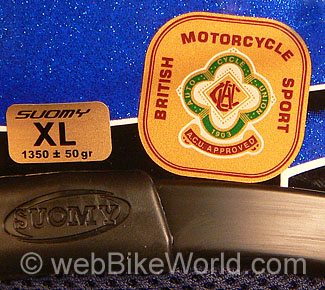New ACU Five Star System to Combine Snell and ECE 22.05 Motorcycle Helmet Safety Standards
The Autocycle Union (ACU Motorcycling GB) fulfills a role in the UK that is similar to the American Motorcyclist Association (AMA) in the U.S.A.
Both serve as the the governing bodies for motorcycle racing, they help organize motorcycle clubs and other issues such as communications with members and interfacing with governmental regulatory agencies.
Both organizations are also the national affiliates of the Federation Internationale de Motorcyclisme (FIM), the overall governing body for motorcycle racing standards. The ACU organization is over 100 years old and was instrumental in the development of the FIM way back in 1904 when motorcycling was in its infancy.
One of the declared roles of the ACU is that “it sets, checks and revises safety standards, which ensure that motorcycle sport is an insurable commodity.” Unlike the AMA, the ACU is involved in motorcycle helmet safety standards through the issuance of the ACU Gold sticker and the less well known ACU Silver sticker.
The ACU Gold sticker has been recognized by many worldwide motorcycle racing governance bodies as a high-level helmet safety standard for motorcycle racing; many of those organizations will only allow motorcycle racers to use helmets with the ACU Gold sticker.
ACU Gold stickers were normally awarded to motorcycle helmets meeting the BSI Type A safety standard, while the ACU Silver stickers were awarded to helmets meeting the BSI Type B standard. But with the adoption of the ECE 22.05 safety standards, the Silver sticker had been discontinued.
However, it was recently found that the ACU has been selling ACU Gold stickers to distributors of many different types of motorcycle helmets whether or not they met BSI Type A. It was claimed that since the ACU received a royalty for the use of the sticker that they were devaluing the worth of the ACU Gold sticker by selling them to many undeserving motorcycle helmet manufacturers.
To ACU’s credit, they have decided to abandon this strategy and attempt to bring back the value of the sticker as a label of confidence to the consumer that the helmet does indeed meet certain safety standards.
The plan is to have a new ACU five star rating for motorcycle helmet safety crash testing. Helmets sold in the UK will now be awarded 1 to 5 stars, depending upon its ability to pass certain tests that are a combination of Snell and ECE 22.05 regulations.
The ACU is working with the UK’s Department for Transport and Head Protection Evaluations (HPE), the certified Snell testing laboratory in the UK, to develop the scheme.
In general, there are differences between Snell and ECE 22.05 standards. Snell tests involve dropping the weighted helmet on a hemispherical anvil and include a penetration test. The penetration test involves a 3kg pointed spike that is dropped on to the helmet.
Some manufacturers claim that the helmet must have a stiffer lining and shell to meet these tests and that may be incompatible with the “softness” needed for lowering of G forces and dwell time on the rider’s head.
In any case, to receive the full ACU five stars, the helmet will have to pass both the Snell and ECE 22.05 tests. We will see how this will affect motorcycle helmet safety standards in the U.S.A.
Don’t forget that many claim that there’s really nothing wrong with the U.S. Department of Transportation (DOT) motorcycle helmet safety standard either (Federal Motor Vehicle Safety Standard No. 218).
It’s claimed that research has demonstrated that 90% of real life crash impacts are at or below the impact requirements of the DOT performance standard for motorcycle helmets (also known as FMVSS 218).
NOTE: This is a developing story. It’s unclear at this point what the new label may look like or what it will be called. If you have further information regarding this topic that you’d like to share with others, please send it to.


